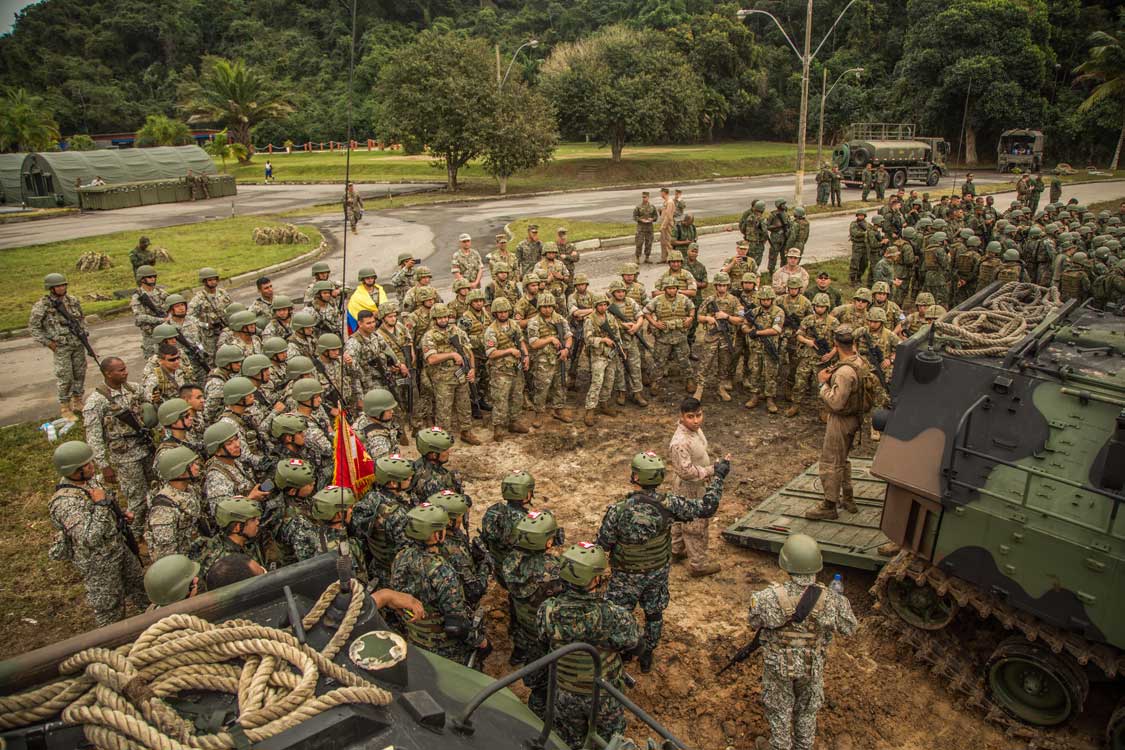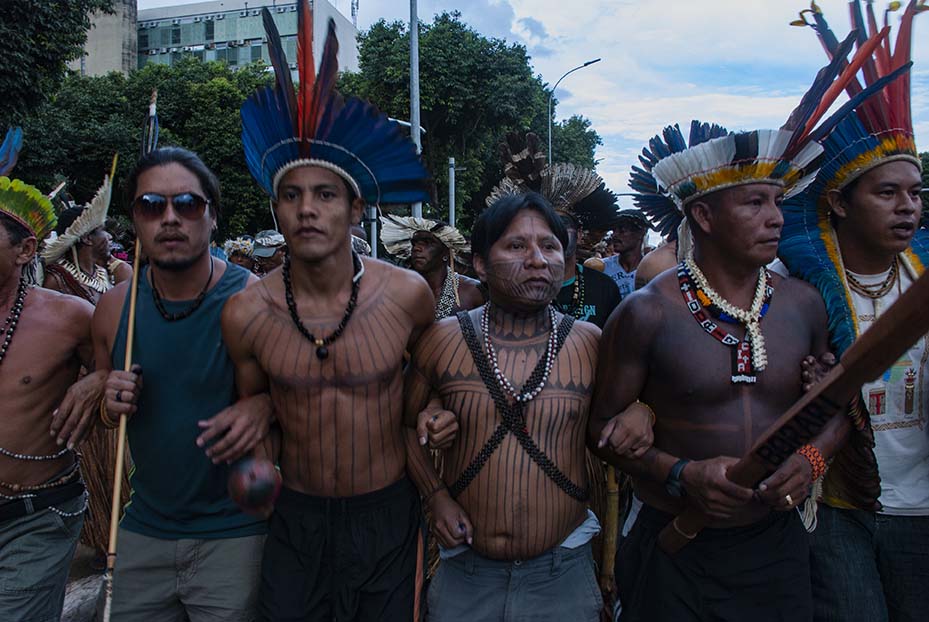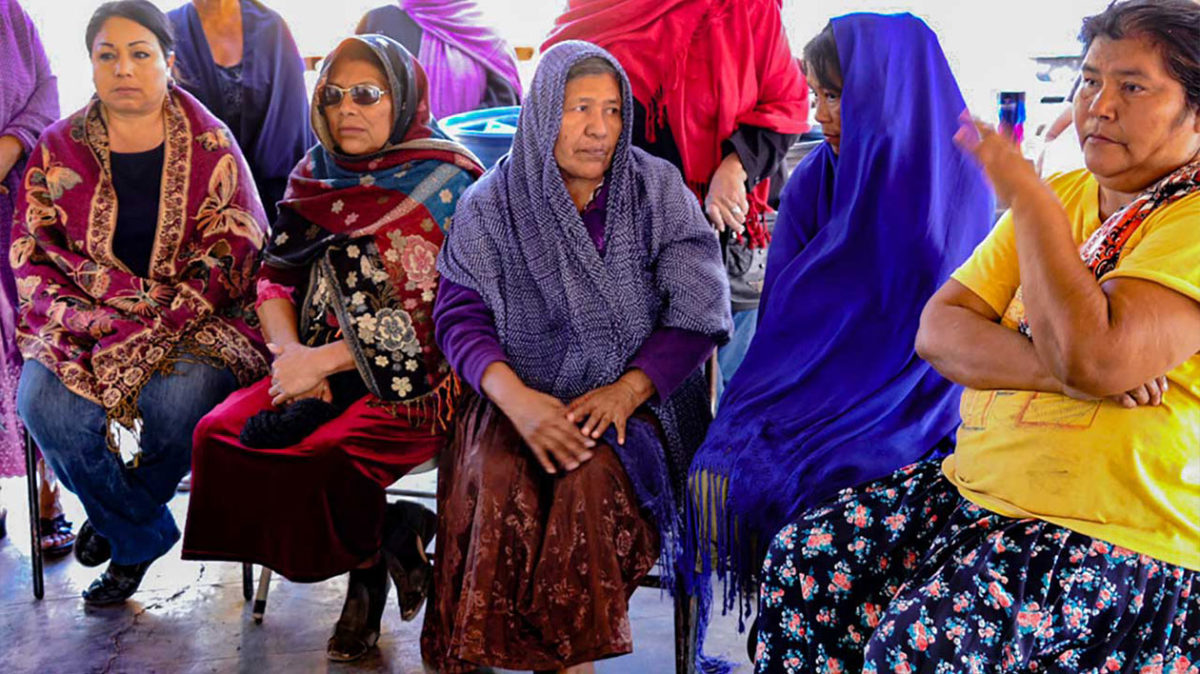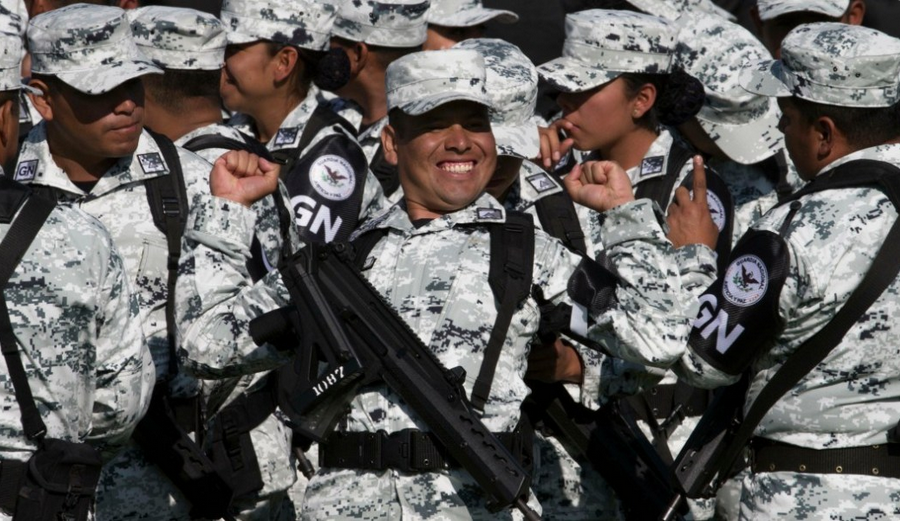60,397 Latin American soldiers have received training from WHINSEC. A large number of them remain active in the militaries of various countries in the region. Only 4,211 soldiers are from Bolivia.
Translated by Leif Johnson
Published 21-11-2019
The credibility that Evo Morales' government had held for 13 years quickly exhausted itself, as he twice violated the constitution he himself had promoted and continued with the same extractivist model as previous governments. This is the background of what today is considered a coup d’état.
In February 2016, Evo Morales had called for a referendum to extend the limits on reelection. Although the referendum failed, he was nominated once again and won the elections – giving him a mandate to govern Bolivia until 2020. This year, he did the same and put himself forward to govern Bolivia until 2025. However, he was accused by the Organization of American States (OAS) of having committed electoral fraud.
In the presidential elections that took place on this past October 20, 2019, after a system outage that lasted several hours, the Supreme Electoral Court of Bolivia announced that Evo Morales had won 47.07% of the vote, followed by Carlos Mesa with 36.51%. This difference was greater than the 10% necessary for an electoral victory in the first round.
Sometime after, observers from the OAS presented a report, dated November 10, 2019, pointing out what they described as “fraud” carried out on behalf of Evo Morales which resulted in his reelection. Alongside the report, dozens of "civic" protests began all over the country. Additionally, several military commanders refused to recognize the results. This was when Morales resigned, following the "suggestion" of the commander of the Bolivian military, Williams Kaliman Romero.
"Everything started when the civic [groups] from Santa Cruz started their blockades, attacking and humiliating women in racist and discriminatory ways. They started this strike to try to take out the MAS government. It happened the same way in Cochabamba and other areas", argued a mother of four from El Alto who wished to remain anonymous.
Immediately following Morales's resignation, Kaliman Romero assumed control of the country and gave a public statement that, because of the increased number of protests and the fact that the police were outnumbered, the military would take action against protesters. "Our Bolivian police has been overwhelmed, and in compliance with our constitutional mission, military command has arranged for the armed forces to engage in joint operations with the Bolivian police in order to avoid bloodshed and grief for the Bolivian family", he announced on November 11.

Two days following the announcement of military presence in the streets, on November 13, the former news broadcaster and opposition senator Jeanine Áñez Chávez proclaimed herself interim President in a ceremony in which the commander Kaliman Romero symbolically passed the presidential sash to her.
Amid intense protests, the principle responsibility of the self-proclaimed interim president of Bolivia, following Evo Morales’ resignation, was to call new elections. However, she did nothing of the sort and instead attempted to justify repression. Áñez decided to declare that the use of force by the police and military would be exonerated, assuring on November 15 that they would be "exempt from legal responsibility when, in compliance with their constitutional function, they act out of legitimate self-defense or necessity, in observance of the principles of legality, absolute necessity, and proportionality, in accordance with Articles 11 and 12 of Penal Code 1760, and the Code of Penal Procedures".
The results were that by Monday, November 18, according to the Interamerican Court of Human Rights, 23 people had been killed and 715 had been injured by firearms exclusively used by the military and police.
"The total is that at least 23 people are dead and 715 are injured since the beginning of the political and institutional crisis", reported the ICHR on social media.
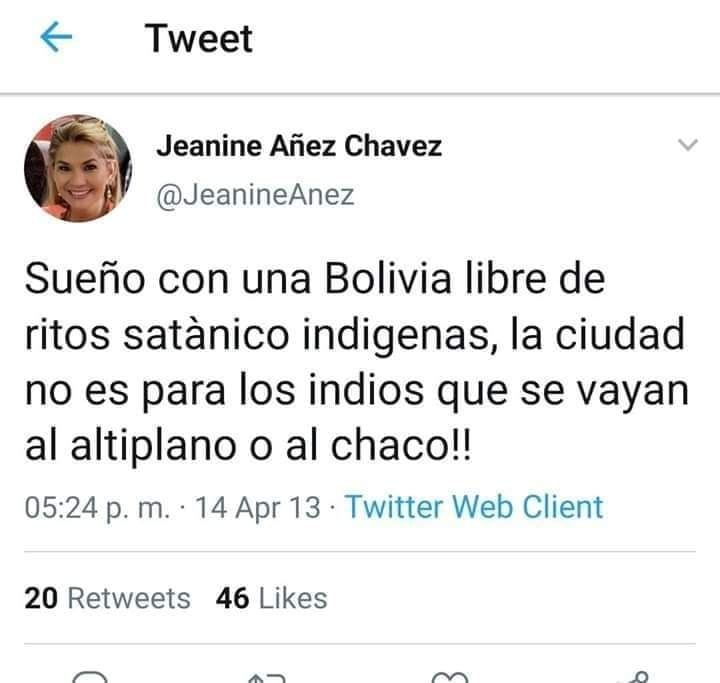
On Tuesday, November 19, three deaths were reported during a brutal joint operation by the police and military which attempted to dissolve the blockade maintained by Morales supporters around a fuel plant in Sankata, 40km from La Paz.
However, Argentine journalist Fernando Ortega Zapala, who covered the repression, affirmed on social media that there were more deaths than reported. "Today I saw 10 dead, four of whom died right in front of me. All were young people. I lost count of the wounded. My hands and clothes are stained with blood", he shared.
From Mexico, in a press conference, Evo Morales affirmed that there are "30 dead, more than a thousand people with gunshot wounds, and more than a thousand arrested".
"Since taking on the position, the supposed president has given free rein to the police and military, who have started to massacre the people. Regrettably, they have snatched people up and taken them away. There are several former leaders of the MAS who have been arrested and whose whereabouts are unknown. This is happening in El Alto, but it's worse in Cochabamba", stated María.
The Military Legacy
The most important link that holds a State together lies, in the first instance, in its legitimacy before the people, as well as in the structures of its military. These structures were inherited by progressive governments in Latin America, militaries that later turned their backs on them. Commander Kaliman Romero, the head of the Bolivian military, who was appointed by Evo Morales in December 2018, justified the use of force following the resignation of the president, assuring that it was directed "against the acts of groups of vandals who are causing terror among the population, reminding the population that the military would never open fire against them". In reality, tension is growing day by day, and repression is out of control.
The military figure who took the reins of this South American country did not emerge from nowhere. Commander Kaliman Romero, like thousands of other Latin American soldiers who have been trained in U.S. military doctrine, is an alumnus of the "Strategy and Defense Politics" course in the former School of the Americas. He also took Commando and Chiefs of Staff courses, from 2003 to 2004, at the same school, which has since been renamed.
In February 2001, following accusations that the school was training soldiers in “torture techniques and how to carry out coups,” the School of the Americas was renamed as the Western Hemisphere Institute for Security Cooperation (WHINSEC) -- the same institution where Commander Kaliman Romero took several courses and where he also shared his experience as a professional military education official.
One of the last events that Kaliman Romero attended was the Conference of American Armies in 2013, also at WHINSEC, located in Fort Benning, Georgia. According to a report by the institution itself, Kaliman, as the commander of the Bolivian military, reunited with old classmates he had taken courses with, such as the Mexican Colonel Federico San Juan Rosales and Peruvian Colonel Aldo Domínguez Peralta.
The Architecture of a Coup
From 1949 to 2004, the former School of the Americas, which has continued as WHINSEC, trained 4,211 Bolivian soldiers. Among Latin American countries, Bolivia has the fifth greatest number of soldiers trained by the United States, following Colombia (10,446), El Salvador (6,817), Perú (4,559), and Nicaragua (4,529). Bolivia has sent more soldiers to the school than Chile and Venezuela, according to the information provided by the school on soldiers graduated from the institution.
Training received by these soldiers range from courses on Military Intelligence, Interrogation, Communications, Peace Operations, Human Rights, Joint Operations, Psychological and Leadership Operations, Civil-Military Operations, Anti-drug trafficking and Counter-insurgency operations, among others.Among these 4,211 Bolivian soldiers, at least five were exposed in a series of 16 audio tapes released November 12, 2019, including conversations and plans for destabilization before the October 20 elections. Kaliman Romero was among them.
In the leaked conversations, it is possible to identify the soldiers involved, who gave their names to other soldiers in order to give instructions on the operations they were directed to carry out. Among them are: Oscar Pacello Aguirre, Remberto Siles Vásquez, Julio C. Maldonado Leoni, Teobaldo Gardozo Guevara, and Manfred Reyes Villa. These five are also graduates of WHINSEC, as evidenced by a check of the database of Bolivian soldiers who have participated in the school.
Oscar Pacello Aguirre (Honors Graduate): Took the Military Intelligence Course for Officers from February 7 to April 18, 1994. Attended the Commando and Chiefs of Staff Course for Officers, January 24 to December 14, 2000.
Remberto Siles Vásquez (Distinguished Graduate): Took the Combat Arms course for Officers from January 6-June 2, 1992.
Julio C. Maldonado Leoni: Took the Commando Instructor and Chiefs of Staff General Officer courses between January 15, 2001, and January 15, 2003.
Teobaldo Cardozo Guevara: Took a course on Basic Foreign Training in November, 1974.
Manfred Reyes Villa: Attended a course in Basic Combat Arms in 1976.
Among the strategies laid out in the recordings, their goal was to attack the homes of supporters of the Movement towards Socialism party (MAS), in order to provoke fear and tension among the population, with the goal of creating a scenario where the coup would not only be justified, but would even obtain popular support.
In the audio tapes, it is also evident that they had obtained backing from the evangelical Church, as well as the Brazilian government, in particular through a supposed confidant of the Brazilian president, Jair Bolsonaro, advisor to an unidentified Bolivian presidential candidate.
In the recordings, Colonel Maldonado Leoni expresses that the plans for attack are aimed expressly at the government. "There's a blockade at the Cuban embassy, the Consulate, and the ambassador's residence. A blockade around the residences of the Cubans who are living in Bolivia. The Civic Committees did it. This is all against the government right now -- why? Because who is really governing this country? It's the Cubans", he is heard stating in tape no. 8. https://bit.ly/37jYnoB
In tape no. 14, (https://bit.ly/2O0noxu), Colonel Oscar Pacello Aguirre introduces himself to the other soldiers, indicating that no resistance would be permitted to the plans or strategic actions to take place between July 23 and October 21, the day of the election. "What are the key moments?" asked the colonel. "August 6 and 7", he answered himself. "Because the 6th is the Civic Patriotism ceremony, and the 7th is the military parade".
Tape 14 continues, indicating that on the chosen dates, there would be a demonstration before the Chiefs of Staff, with placards calling for the military to uphold the constitution. "Because Evo Morales wants to gain legitimacy from these elections", continued Colonel Pacello Aguirre. At this moment, they called Maldonado Leoni via telephone, who stated "We have great hope - more than hope, we have faith in our civic movement [...] conditions are calling out for the youth to direct a whole movement for this country".
For María, it was this very scene which was used to disguise the coup. Since they first allowed for the elections to be carried out, in order to later fail to recognize them and, as so, take to the streets with the patriotic committees to cause destruction in the name of the MAS. "There are demonstrators in the streets who are saying they're from MAS, but they're twisting the discourse for foreign media. As for local media, they've paid them off so that they won't say anything against the self-proclaimed president Áñez", said the resident of El Alto.
Southern Command
Of the 60,397 Latin American soldiers who have received training through WHINSEC, the majority are still active in the militaries of their respective nation-states. WHINSEC also finances trainings in which military units take part in joint exercises directed by the Southern Command of the United States (SOUTHCOM).
The Southern Command is one of nine U.S. military command regions. It includes the southern area of the American continent, Central America, and the Caribbean. Based out of Miami, Florida, SOUTHCOM works with WHINSEC to strengthen relations with associate nations in the region, in particular through a program called "Siempre Listos" ("Always Ready"). This program focuses on three principle areas: an ethics program, a program in democracy and human rights, and the Field Studies Program (FSP), in support of their arms training.
In a classified statement from the Commander of SOUTHCOM, Craig Stephen Faller, dated February 7, 2019, the commander assures that "we work every day to gain the confidence of our partners in Latin America and the Caribbean. We are friends and neighbors, united by shared values and shared participation in our common future".
Following the commander's statement, the document states that relations in the region have improved, especially relations with Brazil, Colombia, and Chile, which are to be considered "forces for regional and global security".
The reinforcement of allied countries has come through "institutional capacity, exchanges of information and intelligence, education, personnel exchanges, and joint exercises. In the past year, we have improved the quality, depth, and frequency of information and intelligence exchanges with our partners, producing joint results on transnational issues of mutual interest", the document announces.
According to the commander of SOUTHCOM, the majority of the nations in this hemisphere share "democratic values - including respect for human rights and adherence to the rule of law - and are interested in the development of democracy and the struggle against radical ideologies".
When the leaders and training documents from SOUTHCOM refer to "radical ideologies", they are explicitly referring to countries that have established relations with six actors: "Russia, China, Iran, and their authoritarian allies in Cuba, Nicaragua, and Venezuela", the SOUTHCOM commander declares.
These are interconnected threats, such as the establishment in Bolivia of Evo Morales' government, because they "challenge the security of our partners in the region", states the SOUTHCOM document.
However, the commander also maintains that their alliances are not only vital, but also a security goal for the United States and its allies. As such, he recognizes the success that has been obtained in building trust between allies and partners, "working with and through our inter-institutional partners such as the Department of State, USAID, the Department of Homeland Security, and the Department of Justice".
One of the individuals who worked as an advisor for SOUTHCOM since 2017 is Liliana Ayalde, the former director of USAID, who took on a variety of civilian duties in the institution, particularly focusing on foreign policy.
In 1982, Ayalde joined USAID through an International Development Internship in USAID - Dhaka. In 1985, Mrs. Ayalde joined USAID-Guatemala during a period of governmental transition. Later, she was sent to Nicaragua, where she led assistance programs through the 1990s. In 1993, she was the Deputy Director of the Office for Central American Affairs, part of the Office for Latin America and the Caribbean. She became the director of USAID in 1995, during the peace processes in the region. She returned to Nicaragua as the Deputy Mission Director for USAID in 1997.
Ayalde was named Mission Director for USAID – Bolivia during the period from 1999-2005. Following this, she was assigned to Colombia until 2008.
From 2008 to 2011, Ayalde made the jump to the position of Ambassador in Asunción, Paraguay, during an electoral process there. According to information published through Wikileaks, the coup that took place against Fernando Lugo was planned by the U.S. Embassy in Asunción, which was headed up by Ayalde at the time.
Following this, and amid tensions between Brazil and the U.S. resulting from accusations of spying in Brazil by the National Security Administration (NSA), Ayalde was named Ambassador to Brazil. The central accusation against the president at the time, Dilma Rousseff, was that she broke fiscal rules, covering up a budget deficit. She was removed from office soon after.
The silence of the U.S. government when it comes to the numbers of deaths caused by the Bolivian military is interesting, but why should call more attention is the immediate statement by the president of the U.S., Donald Trump, who not only celebrated Evo Morales’ resignation, but also claimed that it was a strong signal to "illegitimate regimes" in the Western Hemisphere, among which he included Nicaragua and Venezuela:
"Yesterday's resignation by Bolivian president Evo Morales represents a significant moment for democracy in the Western Hemisphere… The U.S. applauds the Bolivian people for demanding their freedom, and the military for keeping their promise to protect not one person, but the Constitution of Bolivia", Trump announced in the White House.
What is clear in this process is that effectively, the Morales government arrived at a point of exhaustion as a result of its long period of governance and the continuation of the same economic policies put forward by previous governments, albeit with a larger portion of public spending, which benefited vulnerable populations. But it is also clear that U.S. military doctrine has a presence in Bolivia, taking power and imposing a self-proclaimed interim president through a coup d’état.


